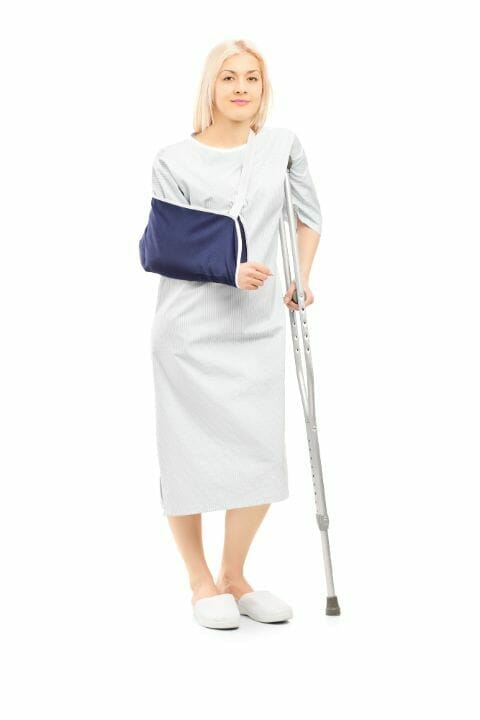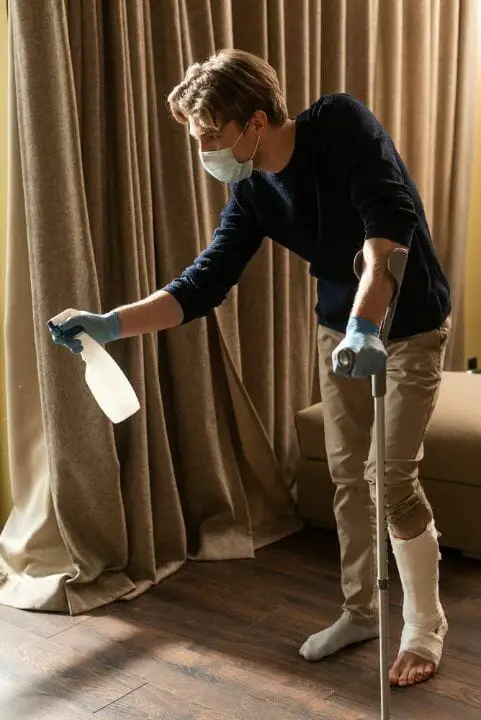Any medical surgery brings with it a set of steps towards full recovery. Hip replacement surgery is no different. There are several dos and don’ts to protect your replaced hip. In addition to these precautions, recovering patients may also use assistive equipment after hip replacement.
One of these sets of equipment is a crutch. Depending on the doctor’s advice, you may use one or two crutches. This article is for you if you want to understand how to use one crutch when you are recovering.
Contents
Hip replacement is done when other treatments like physiotherapy or heat treatment have already been tried with limited or no relief. It is a surgical procedure to replace a painful hip joint with an artificial joint. Most often, the artificial one is made of metal and plastic components.
There are several dos and don’ts to protect the replaced hip. Your doctor or physical therapist will provide you with a set of precautions that will help you prevent any harm to your new joint and help in healing.
In general, you should not crouch the waist beyond 90 degrees for a minimum of two months. Therapists also suggest not to lift the leg higher or lean forward when you sit down. You should also avoid turning your feet when you bend down.
Also, there are a few things your doctor may suggest you do. These may include using a highchair or a barstool to sit instead of a flat chair. When sitting, keep your the leg that is affected in front. You may use cold therapy to alleviate pain or for reducing swelling. Use an ice pack or have it wrapped in a towel, don’t use ice directly. You can also use heating pad for enhanced motion.
By the way, we also wrote a separate article that discusses the other essential equipment such as chair, and raised toilet after a hip replacement.
Be aware of your pain, though. If you start feeling abnormal pain in your affected hip or leg, take a break. However, do not stop your exercises until your doctor or physiotherapist suggests doing that.
In addition to all the precautions that your doctor may suggest, you may also use one or more assistive equipment to help you move around and do your daily chores. In this article, let’s discuss using one crutch after your hip replacement surgery.
Using Assistive Equipment After Hip Replacement
After your hip replacement, you have options for several types of adaptive medical equipment such as a cane, a walker, or one or two crutches.
These are generally used by all patients recovering after a hip replacement procedure. You may also check with your insurance company or government insurance if the cost of these gear is covered as part of your insurance plan.
After your hip replacement surgery, you start with a walker. Once your treated muscles regain enough strength, your physiotherapist may recommend one or two crutches.
The medical specialist will also give you instructions on how far and how long you may walk with the new crutch. So, you must use your assistive device to balance yourself, as instructed by your therapist, while walking.
You may also like Is a Knee Scooter Better than Crutches?
Using Crutches
After the hip replacement procedure, you may have to use it for up to three weeks when you start using a crutch. The duration may even be more if your doctor or therapist believes so for your faster recovery.
For example, if you have received the microfracture or the reconstruction, you may have to use the crutch for a little longer than if you had the standard hip replacement.
The most critical part of using a crutch is understanding how to position it and balance yourself properly. When using a crutch, you should put your weight on your palm, not your armpit.
If you place the crutch correctly, your arm should support most of your body weight. It would help if you also straighten your arm because too much weight on your underarm can damage the nerve. This situation doesn’t arise if you are using an elbow crutch, though.
Once the crutch is placed under the arm on the non-operated side, keep it around three inches away from the foot. This will enhance your stability.
If you have surgery on your right hip and use a single crutch, you hold it in your opposite hand. You will begin to take a step with the right leg and the crutch together. If it were the left leg, you would put the crutch in your right hand.
It will help if you have padding on the handgrip and armpit support on your crutch, as it provides better grip and shock absorption. In addition to that, there are several precautions you should take while using one crutch to walk.
Avoid wearing heavy jackets while walking with a single crutch, as it can impact your movement and stability. If you use a cast or walking boot on one of your feet, you should wear a thicker-heeled shoe on the other foot.
It will ensure that both of your legs are of the same height. It provides better stability and reduces the risk of hip or low back pain.
As you start walking, move your crutch about a foot forward, and step forward with your injured leg. You should then firmly grab the handgrip with your outstretched arm and take a step past the crutch with your healthy leg. You keep repeating this sequence to move forward.
While walking, you should move forward the operated leg and the crutch at the same time. Make sure to line youe leg with the crutch at all times. After that, take small steps through the crutch with your healthy leg.
You should balance yourself by keeping most of your weight on the crutch when stepping with your injured leg. However, make sure you have a firm footing, and there is nothing in your path to trip you up.
As mentioned above, you should not use your armpit to hold your weight as it may cause soreness, shoulder injury, or even nerve damage. If your therapist recommends, you may also use forearm crutches.
You may also like Different Walking Assistance Devices for the Elderly
Walking up and Down the Staircase With Your Crutch
When using a crutch, one of the most challenging activities is walking up and down the stairs. However, it is much more difficult with two crutches than with one crutch.
You can use your crutch to navigate stairs only if stairs have stable and securely attached handrail support adequate to your weight.
However, if there is no stair rail, then look for an elevator or assistance from someone. In case there is no railing, and you could also not find an elevator or someone to help, try to use the stair wall to support yourself, but be very careful.
Let’s look at how to walk up and down stairs using a crutch in little more detail.
Walking Upstairs
When you start climbing the stairs, you should keep the crutch in the arm of your healthy side. To take the first step, you use your hand at your operated side to grab the handrails. Hold the handrail tight at one side and the crutch on the opposite side to take a step up with your healthy leg first.
After that, you bring the crutch and leg up to place them beside your uninjured leg on the same stair. You keep repeating this sequence until you get to the top of the stairs.
You should practice this skill with your doctor or a therapist before you try alone, and when doing it on your own, be extra careful.
You may also like Best Stair Chair Lift For Seniors
Walking Downstairs
While walking upstairs is difficult, walking down the stairs with a crutch is even more dangerous than going up. It is because of the gravitational force in your direction of movement.
Also, the sequence for walking down the stairs is opposite to that of walking upstairs. So if possible, it is always safe to have someone help you down the stairs.
While walking down, try to grasp the handrail firmly. After that, you place the incapacitated leg on the lower step first and then the crutch and your unhurt leg. You should try to take support from your healthy leg and use the operated leg and the crutch for stepping.
However, it would be best if you did not put too much pressure on your injured leg. Sharp pain may make you dizzy and nauseous.
So, you should always focus on maintaining your balance without rushing yourself. You can follow the sequence of taking a step with your operated injured and then healthy leg until you are at the bottom of the stairs. Just be careful of any objects lying on the stairs that might get in your way.
Video demonstration
You may also refer to a youtube video demonstrating how to use one elbow crutch after your hip surgery.
https://www.youtube.com/watch?v=m3nr3pOf1pc
And, if you use a standard armpit crutch, you can refer to this video on youtube to see a demonstration:
https://www.youtube.com/watch?v=rWTidi4C2JA
You may also like Do You Need Crutches With a Walking Boot?
Concluding Your Recovery
As you get stronger, you may increase the amount of activity you do around your home, but do it slowly and carefully.
You may start a few household chores like dusting while still using a crutch before trying the same activity without the crutch.
When you begin to feel no pain in your hip, you may start to take the crutch away in the house. However, take it slowly until your therapist confirms your full recovery.
Experts usually recommend that even if you can all your activities without a crutch, keep it in your car for a few weeks. It will help if you start feeling tired or pain in your operated side when outside the home.


